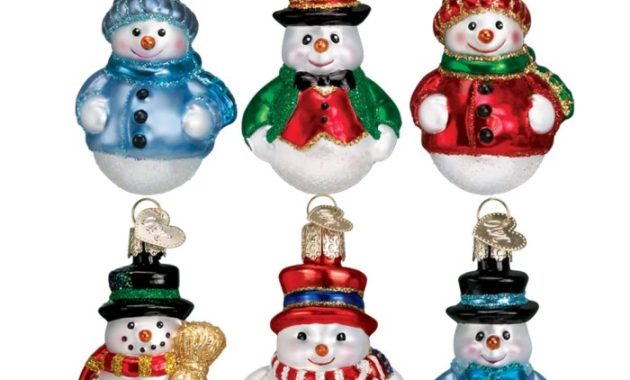Mini Christmas Tree Decoration Styles

Mini christmas tree decoration – Mini Christmas trees offer a delightful way to infuse festive cheer into any space, regardless of size. Their compact nature allows for creative exploration of diverse decorative styles, transforming them into miniature reflections of personal aesthetic preferences. The versatility of these charming trees extends beyond simple ornament placement; they become canvases for expressing unique design sensibilities.
Five Distinct Mini Christmas Tree Decoration Styles
The charm of mini Christmas trees lies in their adaptability. Five distinct styles readily showcase their decorative potential: Rustic, Modern, Traditional, Whimsical, and Glamorous. Each style employs specific materials and color palettes to create a unique visual impact.
- Rustic: This style evokes a sense of warmth and natural charm. Think natural wood bases, pinecones, berries, and muted-toned ornaments. Twigs and slices of wood can be incorporated as embellishments, adding texture and a touch of the outdoors. The overall aesthetic is cozy and inviting.
- Modern: Clean lines and minimalist aesthetics define the modern style. Metallic ornaments in silver, gold, or copper are frequently used, alongside geometric shapes and monochromatic color schemes. A sleek, simple tree stand complements the overall sophisticated feel.
- Traditional: This style embodies classic Christmas imagery. Red, green, and gold ornaments are dominant, often featuring traditional shapes like stars, bells, and candy canes. Garlands and ribbons add to the festive atmosphere. The overall impression is one of timeless holiday elegance.
- Whimsical: This style embraces playful creativity. Unusual ornaments, handmade decorations, and bright, unexpected color combinations create a fun and personalized touch. Think felt animals, miniature toys, or quirky handcrafted items. The overall effect is lighthearted and charming.
- Glamorous: Opulence and sparkle define this style. Ornaments made of glass, crystals, or glitter add a touch of luxury. Rich colors like deep reds, purples, and golds create a sophisticated and extravagant look. The overall impression is one of refined festivity.
Comparison of Rustic, Modern, and Traditional Mini Christmas Tree Styles
The choice of mini Christmas tree style often reflects personal taste and home décor. The following table highlights the key differences between rustic, modern, and traditional styles:
| Style | Materials | Color Palette | Overall Impression |
|---|---|---|---|
| Rustic | Natural wood, pinecones, berries, twigs, burlap | Earthy tones, browns, creams, muted greens | Warm, cozy, natural |
| Modern | Metallics (gold, silver, copper), geometric shapes, minimalist ornaments | Monochromatic, metallics, whites, blacks | Clean, sleek, sophisticated |
| Traditional | Glass ornaments, ribbons, garlands, candy canes | Red, green, gold, white | Classic, festive, timeless |
Mini Christmas Tree Versatility in Different Interior Design Settings
Mini Christmas trees effortlessly adapt to various interior design styles. Their compact size makes them ideal for accentuating different aesthetic approaches.
- Farmhouse: A rustic mini Christmas tree, adorned with burlap ribbons and natural elements, perfectly complements the cozy, homey atmosphere of a farmhouse setting. The natural materials blend seamlessly with the overall rustic aesthetic.
- Minimalist: A modern mini Christmas tree, featuring a simple design and monochromatic color scheme, adds a touch of festive elegance without overwhelming a minimalist space. The clean lines and understated design maintain the overall simplicity of the décor.
- Bohemian: A whimsical mini Christmas tree, incorporating handmade decorations, vibrant colors, and eclectic ornaments, injects a playful and personalized touch into a bohemian interior. The unique and expressive decorations align with the free-spirited nature of bohemian style.
Mini Christmas Tree Decoration Trends

The miniature Christmas tree has evolved from a simple tabletop accent to a significant design element, reflecting broader interior design trends and personal style. This year, we see a fascinating interplay of classic charm and modern innovation shaping the way we decorate these festive miniatures. The trends we’re observing are not merely fleeting fads, but rather a reflection of our evolving aesthetic sensibilities and a desire for both personalized expression and sustainable practices.
Emerging Mini Christmas Tree Decoration Trends
Three key trends are shaping the mini Christmas tree landscape for the upcoming holiday season: a resurgence of maximalist decoration, the increasing popularity of eco-conscious choices, and the integration of personalized, handcrafted ornaments. These trends demonstrate a move away from minimalist uniformity toward expressive and individualistic displays.
The Influence of Current Design Aesthetics
Current design aesthetics, heavily influenced by biophilic design and a renewed appreciation for handcrafted items, significantly impact mini Christmas tree choices. The move towards natural materials, such as wood, rattan, and sustainable paper, is prominent. We also see a shift away from perfectly symmetrical decorations towards a more organic, slightly imperfect aesthetic that embraces asymmetry and natural variations in color and texture.
Mini Christmas trees offer a charming, space-saving alternative to larger decorations, perfect for smaller spaces or as supplementary festive accents. However, for a truly immersive Christmas atmosphere, consider larger-scale decorating, such as adorning your television with festive cheer, as detailed in this helpful guide on christmas decoration for tv. Ultimately, the mini tree’s charm lies in its versatility; it complements, rather than competes with, other larger decorations.
This reflects a broader cultural shift towards embracing imperfections and celebrating individuality. The emphasis on natural textures and earthy tones, so prevalent in home decor, translates directly into mini Christmas tree decoration choices, creating a harmonious blend between the tree and its surrounding environment.
A Hypothetical Mini Christmas Tree Decoration Trend for Next Year
Next year, envision a mini Christmas tree trend centered around the concept of “Winter Wonderland in Miniature.” Imagine a tiny, frosted artificial tree, perhaps a delicate, snow-dusted pine, nestled in a miniature, moss-covered ceramic planter. The ornaments would be handcrafted from natural materials: tiny, hand-painted clay snowflakes, miniature pinecones dipped in iridescent white paint, and delicate, frosted berries crafted from polymer clay.
The overall effect would be one of ethereal beauty, evoking the feeling of a miniature winter scene captured in a snow globe. The color palette would be predominantly white, silver, and pale blues, with hints of blush pink and deep forest green in the berries and pinecones, creating a subtle, elegant contrast. The light would be provided by a set of tiny, battery-operated fairy lights, subtly illuminating the delicate ornaments and creating a soft, magical glow.
This design would appeal to those seeking a sophisticated, yet whimsical, Christmas decoration that embodies both elegance and a touch of fairytale charm.
Mini Christmas Tree Decoration Materials and Sustainability
Choosing the right materials for your mini Christmas tree decorations is crucial, not only for aesthetics but also for environmental responsibility. The festive spirit shouldn’t come at the cost of our planet’s well-being. This section explores the trade-offs between natural and artificial materials, and offers practical tips for crafting eco-conscious miniature Christmas trees.The decision between natural and artificial materials for mini Christmas tree decorations involves a careful consideration of environmental impact and longevity.
Natural materials, such as twigs, pinecones, and dried flowers, offer a rustic charm and decompose naturally, minimizing long-term waste. However, sourcing these materials sustainably requires careful consideration – avoiding endangered species and harvesting responsibly. Artificial materials, on the other hand, offer durability and reusability, reducing the need for repeated purchases. However, their production often involves plastics and energy-intensive processes, leading to a significant carbon footprint.
The key is to make informed choices, weighing the pros and cons of each option.
Natural Versus Artificial Materials: A Comparative Analysis
Natural materials provide a unique, handcrafted aesthetic, often imbued with a sense of rustic charm. Think miniature trees crafted from carefully arranged twigs, adorned with dried orange slices and cinnamon sticks. These decorations possess a warm, organic quality that artificial materials struggle to replicate. However, the lifespan of natural materials is limited; they may dry out, become brittle, or even attract pests.
Conversely, artificial materials, often made from plastics or synthetic fibers, offer longevity. A well-made artificial mini Christmas tree can last for many years, reducing the need for frequent replacements. However, the manufacturing process of these materials often involves significant energy consumption and the release of harmful chemicals. The ultimate choice depends on individual priorities – prioritizing aesthetics and a short-term impact versus prioritizing longevity and minimizing long-term environmental consequences.
Five Tips for Eco-Friendly Mini Christmas Tree Decorations
Creating eco-friendly mini Christmas trees is easier than you might think. By making conscious material choices and employing simple crafting techniques, you can minimize your environmental impact while still enjoying the festive spirit.
- Prioritize recycled and repurposed materials: Instead of buying new materials, explore your home for items that can be repurposed. Old buttons, fabric scraps, and even recycled paper can be transformed into charming decorations.
- Choose sustainable natural materials: Opt for sustainably sourced natural materials like twigs and pinecones from your own backyard (if possible and permissible) or ethically sourced from local suppliers. Avoid materials that are endangered or require excessive processing.
- Reduce plastic use: Minimize the use of plastic materials. Instead of plastic ornaments, consider using natural materials like dried fruits, nuts, or small wooden beads.
- Embrace biodegradable decorations: Choose decorations that will decompose naturally after the holiday season, such as paper ornaments or decorations made from natural fibers.
- Support ethical and sustainable businesses: When purchasing decorations, support businesses that prioritize sustainability and ethical sourcing practices. Look for certifications or labels that indicate environmentally friendly manufacturing.
Upcycling and Repurposing Materials for Mini Christmas Tree Decorations
Upcycling and repurposing materials offer a fantastic opportunity to create unique and sustainable mini Christmas tree decorations while reducing waste. Old jars can be transformed into miniature snow globes, while discarded fabric scraps can be fashioned into charming ornaments. The possibilities are endless. Consider using old Christmas cards to create unique tree toppers or using leftover yarn to knit miniature ornaments.
Even coffee filters can be repurposed into beautiful paper flowers. The creative possibilities are limited only by your imagination and the materials at your disposal. This approach not only reduces waste but also allows for personalized and truly unique decorations.
Common Queries
What are the best adhesives for mini Christmas tree decorations?
Hot glue is ideal for strong bonds, while craft glue is suitable for delicate materials. Consider using double-sided tape for lightweight ornaments.
How can I prevent my mini Christmas tree from drying out if using natural materials?
Keep natural mini Christmas trees away from direct heat and moisture. Consider misting them lightly with water if they appear dry.
Where can I find unique miniature Christmas tree stands?
Specialty craft stores, online marketplaces, and antique shops often offer unique miniature tree stands. Repurposed items like small teacups or jars can also serve as creative stands.
How do I store mini Christmas trees after the holidays?
Carefully remove ornaments, wrap the trees in acid-free tissue paper, and store them in a cool, dry place to protect them from damage and dust.







